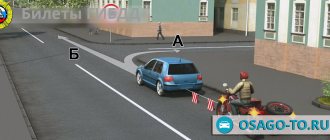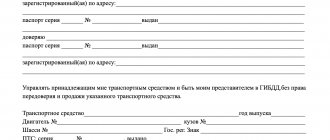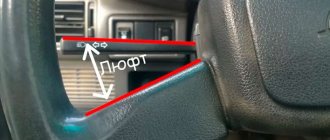To drive a car, you must have a driver's license with an open category corresponding to the type of vehicle. In some cases, it is sufficient for traveling by car with an attached trailer. However, there are a number of restrictions, in the presence of which it is necessary to open also subcategory “E”. Drivers with subcategory licenses “E to B”, “E to C” and “E to D” have all permissions to drive a car with any trailer, but what to do if they only have categories “B”, “C” or “D”?
When a trailer license is not needed
In paragraph 1 of Art. 25 of the Federal Law “On Road Safety” lists the criteria for admission to driving vehicles. The norm provides for cases in which it is permitted to connect with a trailer without a category “E” certificate. For drivers of passenger cars, the following situations are exceptions:
- if the total weight of the trailer does not exceed 750 kg;
- if the weight of the trailer is more than 750 kg, but less than the weight of the car without load, provided that the total composition is less than 3.5 tons.
The same article also considers cases in which a trailer is coupled to cargo and passenger vehicles. They do not require opening category “E” only when connecting a trailer with a gross weight of up to 750 kg.
Conditions for using trailers weighing more than 750 kg
In 2021, licenses will be required not only for a trailer for a passenger car, but also for a trailer. Category “B”, according to the traffic rules, gives the right to drive cars and small trucks, SUVs (jeeps), minibuses, sidecars, vehicles with trailers with a maximum permitted weight of up to 0.75 tons. If this figure is more than 750 kg, then such a vehicle composition must meet the additional requirements specified in Art. 25 196-FZ for 2021:
- The permissible maximum weight of the trailer must not be greater than the unladen weight of the vehicle .
- The sum of the permitted maximum weight of both vehicles should not exceed 3.5 tons .
- If these criteria are not met, the driver will need to obtain category “BE” on a new driver’s license.
What is the permissible weight of a trailer and how to find it out
The permissible weight of a trailer, also known as gross or maximum weight, is the sum of its actual weight with the permissible load capacity. This value is indicated in the corresponding column of the PTS and the registration certificate. It is this that is the main guideline for determining the need to open category “E”, taking into account the weight of the car for the bunch.
There are 4 weight categories of trailers:
- O1 – 750 kg;
- O2 – from 750 to 3500 kg;
- O3 – from 3.5 t to 10 t;
- O4 – over 10 tons.
A trailer belonging to category O1 can in any case be used by a driver with a license of category “B”, “C” or “D”, regardless of the weight of the vehicle itself. Heavier O2 trailers almost always need to be driven by a driver with an "E" license, although there are exceptions for a "B" license. They allow you to drive a vehicle or road train if the vehicle itself is heavier than the trailer, and together they fit into the weight limit of 3.5 tons. For such an exception, category “B” is sufficient. Heavier O3 and O4 trailers require “CE”, “DE”, “C1E” and “D1E” licenses.
What documents are needed for a trailer?
To obtain documents for a trailer for a car, you need to submit an application for registration of the trailer with the State Traffic Safety Inspectorate. The trailer must be registered with the traffic police at your place of residence; registration must be completed within five days from the date of purchase. Next, you need to check the license plate, the year of manufacture, which must match the year indicated in the vehicle passport, and identification of the color of the sides. The make and model, identification number, body and frame numbers must match the instructions on the vehicle title. When the traffic police inspector certifies the completion of such an inspection, you will need to pay a state fee for registration.
What documents need to be submitted to the traffic police to register a trailer?
After checking the correctness of all documents, the trailer will be registered and a stamp will be placed in the vehicle passport indicating that the trailer is registered.
What category is needed for a car with a trailer?
For cars whose trailers do not weigh more than 750 kg, category B licenses are sufficient, but if this threshold is exceeded, then a driver’s license for a towing vehicle is required. A maximum weight is also permissible, which does not exceed the curb weight of a category “B” vehicle. In this case, the maximum weight of the car with a trailer should not exceed 3500 kg. Otherwise, it will be necessary to open category “E”, then the weight of the trailer may be higher than 750 kg.
Of course, to obtain a license of another category, you will need to go to a driving school, take courses and pass an exam at the state traffic inspectorate.
What are the rules for using car trailers?
If you want to use a car trailer with a passenger car, then its weight should not exceed the weight of the towing vehicle of category “B”. Also, for this you must have a tow hitch (towbar), and on the trailer itself you must install brake lights and turn signals, and electrical wiring for lighting.
Do I need to have my trailer inspected?
From January 1 of this year, technical inspection in Russia for trailers that belong to individuals and have a permitted weight of up to 3500 kg has been cancelled. Now only legal entities will undergo technical inspection of trailers.
What are the rules for passing inspection of a trailer for a passenger car?
Such a technical inspection is carried out once every two years, if the trailer is not older than five years. For trailers whose age exceeds this threshold, inspection must be carried out once a year.
The inspection ticket indicates the month and year when the owner must undergo a technical inspection of the trailer at the State Traffic Inspectorate. For convenience, the date of passage most often coincides with the date of vehicle inspection or coincides with the last digit of the registration plate.
Examples of calculations to determine the required category of rights
For a better understanding, consider a table with examples of calculations based on the weight of a trailer and a car.
| Machine weight, kg | Trailer weight, kg | Required category of rights | Explanation of calculations |
| 720 | 750 | B | The trailer belongs to category O1. |
| 1250 | 1050 | B | Although the trailer belongs to the O2 category, it is lighter than a car. Together they do not exceed 3.5 tons. |
| 950 | 1050 | BE | The car is lighter than an O2 category trailer. |
| 3100 | 850 | BE | Although the O2 trailer is lighter, together with the vehicle they exceed 3.5 tons. |
| 3100 | 740 | B | The trailer weighs less than 750 kg. |
| 1950 | 2100 | BE | The trailer is heavier, and together with the car they exceed 3.5 tons. |
| Machine weight (kg) | 720 |
| Trailer weight (kg) | 750 |
| Category of rights | B |
| Explanation of calculations | The trailer belongs to category O1. |
| Machine weight (kg) | 1250 |
| Trailer weight (kg) | 1050 |
| Category of rights | B |
| Explanation of calculations | Although the trailer belongs to the O2 category, it is lighter than a car. Together they do not exceed 3.5 tons. |
| Machine weight (kg) | 950 |
| Trailer weight (kg) | 1050 |
| Category of rights | BE |
| Explanation of calculations | The car is lighter than an O2 category trailer. |
| Machine weight (kg) | 3100 |
| Trailer weight (kg) | 850 |
| Category of rights | BE |
| Explanation of calculations | Although the O2 trailer is lighter, together with the vehicle they exceed 3.5 tons. |
| Machine weight (kg) | 3100 |
| Trailer weight (kg) | 740 |
| Category of rights | B |
| Explanation of calculations | The trailer weighs less than 750 kg. |
| Machine weight (kg) | 1950 |
| Trailer weight (kg) | 2100 |
| Category of rights | BE |
| Explanation of calculations | The trailer is heavier, and together with the car they exceed 3.5 tons. |
Carrying out calculations does not require complex mathematical calculations, so everyone can handle them. It is necessary to take into account that State Traffic Inspectorate employees check drivers of cars with a trailer to ensure that they have the necessary category of driving license. To do this, you will need to provide a driver’s license and a certificate of registration of the car and trailer at the request of the traffic police officer.
Documents when transporting a trailer
Clause 2.1 of the traffic rules:
2.1. The driver of a motor vehicle is obliged to:
2.1.1. Carry with you and, at the request of police officers, hand over to them for verification:
- registration documents for this vehicle (except for mopeds), and if there is a trailer, also for the trailer (except for trailers for mopeds);
That is, in addition to documents for the car, the driver must have with him a trailer registration certificate .
Naturally, the trailer itself must have numbers (registration plates):
2. On motor vehicles (except for mopeds, trams and trolleybuses) and trailers, registration plates of the appropriate type must be installed in the places provided for this purpose, and on cars and buses, in addition, a license card must be placed in the lower right corner of the windshield in prescribed cases.
Responsibility for lack of rights of subcategory “E”
Illegal use of a vehicle in conjunction with a trailer in accordance with traffic regulations is punishable by law. It is the responsibility of every motorist using a trailer to ensure that he has the right to do so. If category “E” is required, then using a trailer in its absence is equivalent to driving without a license. According to Part 1 of Article 12.7 of the Administrative Code, such a violation entails liability in the form of a fine from 5 to 15 thousand rubles.
In addition to drawing up an administrative protocol, norm 27.12 of the Code of Administrative Offenses is applied to withhold a fine. She demands that the violation be stopped by removing the driver from the vehicle. The car itself with the trailer in accordance with Art. 27.13 Code of Administrative Offenses sent to the impound lot. Finding a car in a penalty area is accompanied by additional costs, which, depending on the region and duration of parking, can be equal to or exceed the amount of the fine itself. Thus, driving a car with a heavy trailer, the weight of which requires category “E”, is extremely undesirable.
Drivers may also be fined for overloading a trailer, so the lack of a suitable category of license may also result in it being weighed. When loading in excess of the permissible norm, Art. 12.21 of the Administrative Code, which provides for liability for violation of transportation and towing rules. It provides for a fine of 500 rubles.
We manage according to the Rules
What is the fine for driving without category E? Clause 2.1.1 of the Traffic Rules stipulates that the driver must have with him and, at the first request of the traffic police, present for verification a driver’s license of the appropriate category.
If the category opened in the certificate does not correspond to the vehicle driven by the motorist, then the traffic rules regard such a situation as driving without a license at all.
For violation of this paragraph of the traffic rules, administrative liability is provided under Part 1 of Article 12.7 of the Code of Administrative Offenses of the Russian Federation. The driver can be fined from 5 thousand rubles to 15 thousand rubles.
In addition to an impressive fine, the motorist will be subject to administrative sanctions under Article 27.13 of the Code of Administrative Offenses of the Russian Federation:
- the driver will be removed from driving the car;
- the car will be detained and sent to the impound area with the help of a tow truck;
- The car will be stored at the impound area until the reason for the detention is eliminated.
In practice, it looks like this: the traffic police inspector draws up a report on an administrative offense (driving without a license) and a report on the detention of the vehicle. Then he calls a tow truck and is present at the place where the car was detained until it is sent to the impound area.
The costs for loading, unloading and moving the car with a tow truck, as well as storing it at the impound area, are paid by the penalty driver. Moreover, the longer the car is in the territory of the so-called specialized parking lot (penalty area), the more expensive it will cost the car owner.
Thus, a driver who drives a vehicle without the appropriate entry on his license runs the risk of being fined a fairly large amount of money. Sanctions are not applied only in one case, when a student is driving and an instructor who has a certificate with the required letter is sitting next to him.
What can be done to reduce “costs”
You should know that clause 1.1 of Article 27.13 of the Code of Administrative Offenses of the Russian Federation provides that the detention of a car can be stopped directly at the place where it is stopped by the traffic police inspector if the offending motorist finds a driver who has the required category of license open before the tow truck starts moving.
Therefore, when a motorist is stopped by a traffic police inspector to check documents and discovers that he does not have an open category that allows him to drive a vehicle with a trailer, the car owner urgently needs to find a driver he knows with the required category and ask him to immediately come to the place where the offense was registered.
If a relative or friend manages to arrive by taxi approximately half an hour before the administrative violation report is drawn up at the right place, he will drive the car to a garage or parking lot and, thus, will be able to avoid unnecessary expenses for tow truck services and storage of the car in penalty area.
So, start immediately calling your relatives and declaring a general “alarm.” It is important for you to gain time.
Trailer lights
Paragraph 19.1 of the traffic rules:
19.1. In the dark and in conditions of insufficient visibility, regardless of the road lighting, as well as in tunnels, the following lighting devices must be turned on on a moving vehicle:
- on trailers and towed motor vehicles - side lights.
The side lights on a trailer must be turned on in the following cases:
- in the dark;
- in conditions of poor visibility;
- in the tunnels.
Features of category C
Freight transport falls into this category. It may also include: pickups, minivans, KamAZ, dacha trailer and many other vehicles. Their minimum weight is 3 tons 500 kg. In addition, a small trailer can be attached to such vehicles, the permissible maximum weight of which is less than 0.75 tons. Having received a driver's license with category C, the motorist automatically receives subcategory C1.
It is also worth noting that due to the fact that the car owner knows how to drive a category C car with a trailer, a large number of different professions are available to him. For example, there is an opportunity to engage in all kinds of cargo transportation, drive a truck crane, work as a truck driver, or drive a forklift. Drivers with a category C license are always in demand, and they always have the opportunity to find a well-paid job.










